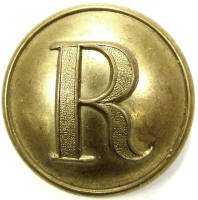
A virtual examination of artifacts of the American Civil War
by Harry Ridgeway
 |
Ridgeway Civil War Research Center, A virtual examination of artifacts of the American Civil War |
| Civil War Artillery | |
by Harry Ridgeway |
| Rifled artillery projectile, Dyer design, Federal manufacture, bursting shell, "case shot" balls packed in sulfur matrix, rounded nose, lead cup sabot, with flame grooves, Dyer zinc time fuze, Ordnance rifle, 3in. Projectile was manufactured in the Federal arsenals following the invention of Alexander Dyer. The sabot system utilized was an expanding lead cup around the base. This pattern features the sabot with a concave bottom, and a groove around the top, three flame grooves were cut into the sabot so that flame from firing would pass through the sabot and ignite the fuze, nose of the shell is rounded. Some of these shells were configured as case shot (approx 10lbs to 11lbs. with balls), or as "common" (approx 8lbs. to 9lbs. without balls). This shell is "case shot", explosive charge with lead balls, and with a time fuze was designed to detonate above the heads of troops in the open field. Lead balls are packed in yellow or sulfur matrix. Fuze employed was a Dyer zinc time fuze, with spanner holes, and without a flange, the time fuze for case shot will have a small opening into the chamber, Jones, Fuzes, pg. 36, left. Projectile measures: diameter 2.94in., length 7in. (excluding fuze), weight 9.5lbs. to 11lbs. Research Center: Artillery4016-Dyer, Ref: Dickey & George, Field Artillery (1993 Edition), pg. 145. Details click: http://relicman.com/artillery/Artillery4016-Dyer.html. |
| Ridgeway Civil War Research Center, A virtual examination of artifacts of the American Civil War. Artillery Research center, artillery, click: http://relicman.com/artillery/Artillery0000-Index.html. Research center, artillery, click: http://relicman.com/artillery/Artillery0000-Index.html. |
| Civil War Relicman, Harry Ridgeway, Civil War artillery, Relicman sales catalog. Click here: http://relicman.com/artillery/RelicmanSalesArtillery1.html. Artillery for sale: http://relicman.com/artillery/RelicmanSalesArtillery1.html. |